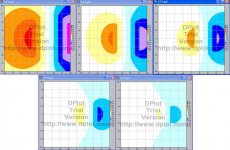Is the bold part why I miss more playing one pocket when rolling the slow ones?
Most likely, though if one has a tendency to hit a little on the inside of the CB on soft strokes, swerve can add to this effect.
I'll attach a throw chart for a 1/2 ball right to left cut from slow (top left) to hard (bottom right). This is the variation relative to a medium speed natural rolling pot.
The top left, slow chart, center top of image indicates that a slow rolling pot will undercut a little over 1/2 inch per yard compared to medium speed follow.
Edit: Note that this slow speed is for about 1 table length of roll for the CB. On softer shots, as the pattern indicates, throw may reach a couple of inches per yard.
Attachments
Last edited:
